前端打包工具 Mako 架构解析|得物技术
- 2024-07-16 上海
本文字数:13388 字
阅读完需:约 44 分钟

一、Mako 是什么
Mako 是一个新的 Web 打包工具,适用于 Web 应用、库和框架。它被设计得快速、可靠且易于使用。Mako 已被数百个生产项目中使用。如果你正在寻找一个现代的 Web 打包工具,Mako 是正确的选择。
二、特点
零配置
从一个 JS/TS 文件开始,Mako 将处理其余部分。开箱即支持 TypeScript、Less、CSS、CSS Modules、React、图像、字体、WASM、Node Polyfill 等。不需要配置加载器、插件或其他任何东西。
生产级
Mako 是可靠的。它被数百个项目使用,如 Web 应用、混合应用、小程序(部分)、低代码、Serverless、库开发、Ant Design 等。还在数千个旧项目和数千个 npm 包以及不同版本中测试了 Mako,以确保兼容性。
快如闪电
Mako 被设计得快如闪电。在核心打包逻辑中使用 Rust,并在 Node.js 中使用 piscina 来并行编译文件。在基准测试中,Mako 比其他 Rust 打包工具和 Webpack 更快。
热模块替换
当文件更改时,Mako 将自动更新浏览器中的代码。无需手动刷新页面。Mako 已集成 React 快速刷新,当你更改 React 组件时,它只会更新组件,而不是整个页面。
代码拆分
Mako 内置代码拆分支持。你可以使用动态导入将代码拆分为单独的包,从而减小初始包大小并加快加载时间。Mako 具有可配置的选项,你可以用来自定义代码拆分行为。
Module Concatenation
Module Concatenation 是一种优化功能,旨在减少包大小和运行时开销。Mako 实现了与 Webpack 优化文档中的实现相当的 Module Concatenation。
三、性能测试
通过冷启动、根 HMR、叶 HMR、冷构建等多个基准测试可以看到,Mako 相较于其他构建工具,有着更好的性能。

benchmark 基准测试 https://github.com/umijs/benchmark
四、项目架构
entry

现阶段,可以有三种途径来使用 Mako 构建,分别是:
通过引用 Mako 的 Rust crate 来发起,其核心模块均已导出(不过好像未发布到 crates.io);
通过引用 Mako 的 npm 包来在 nodejs 中发起;
通过 Mako 的 cli 来发起。
其中,这三种又都是递进关系
Rust 实现 Mako 编译的核心逻辑并进行导出。
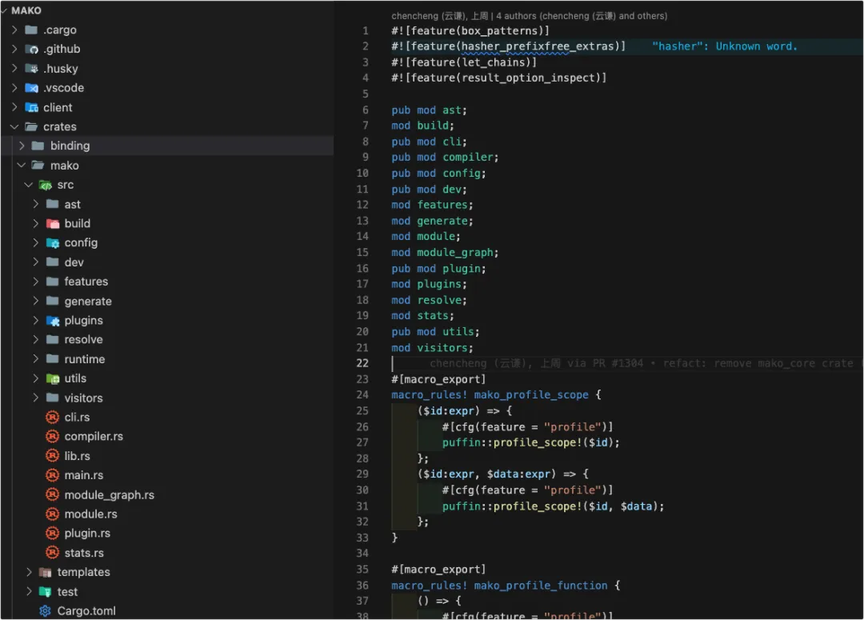
Mako crate 中核心模块导出
通过 napi 将 Mako 核心逻辑的 Rust 代码,经过胶水层,在 github workflows 中进行交叉编译,编译出多平台的 native 模块,然后在 npm 模块中进行引用,再次进行一层封装供用户使用。
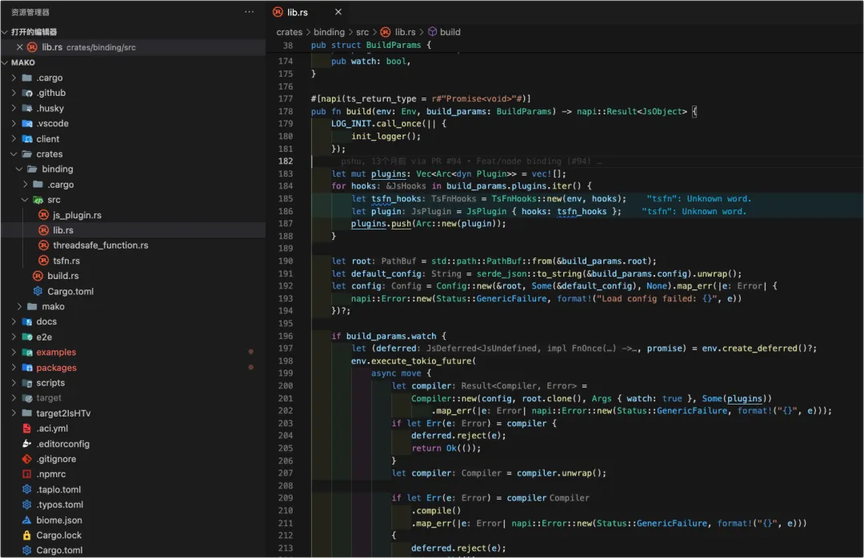
使用 napi 进行编译的胶水层代码
此代码经过编译后,可在 nodejs 中进行引用,有关 napi 的具体细节请参考 https://napi.rs/cn
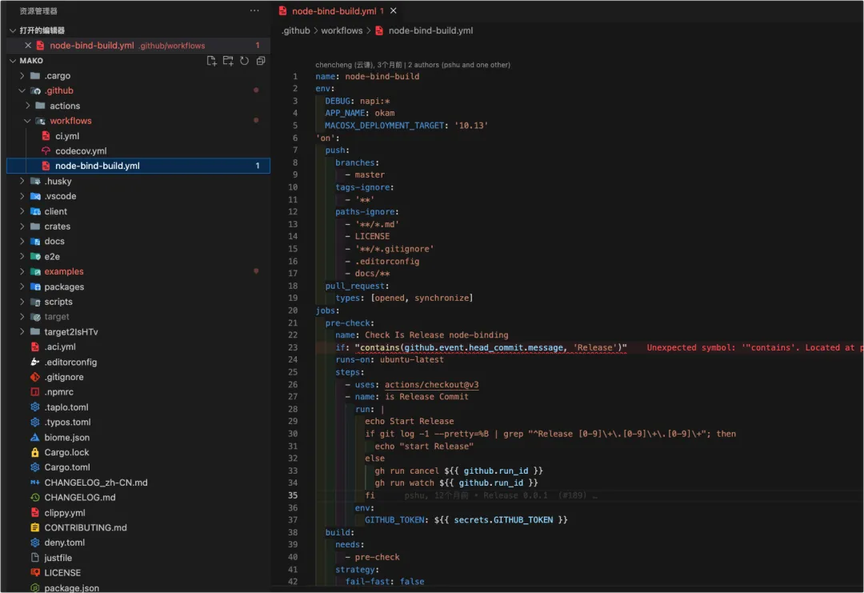
交叉编译任务的 workflows
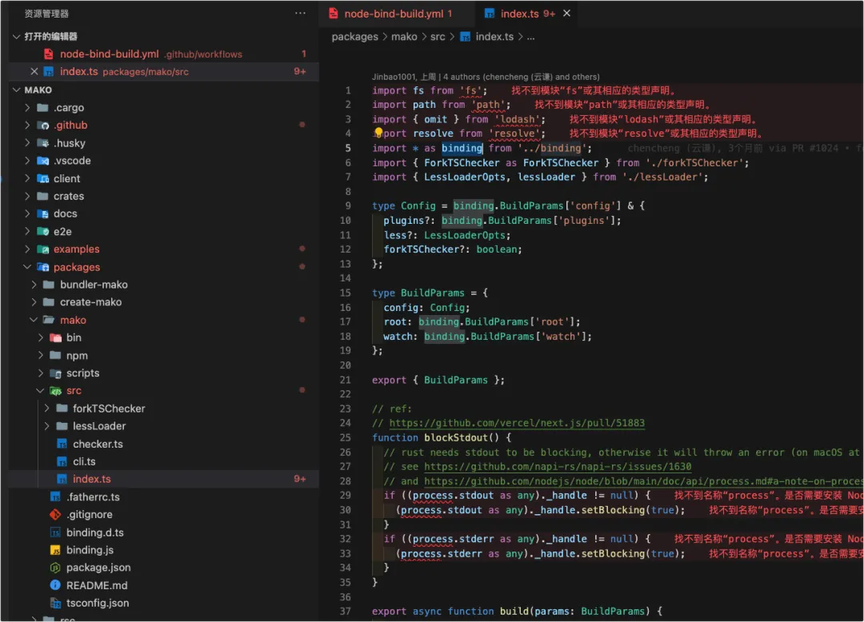
js 层引用编译好的 native 模块,封装后暴露给外部使用
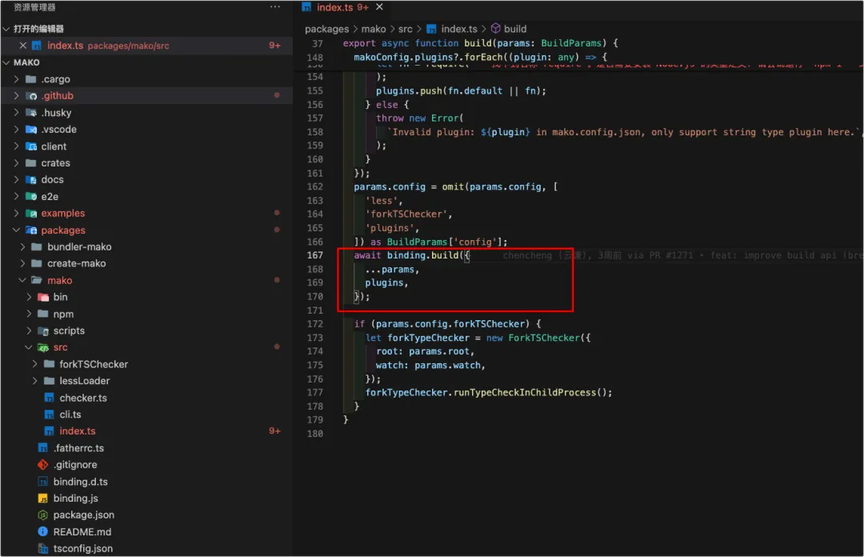
经过 js 层的参数融合后,最终使用 native 模块进行构建
在前两步已经将功能、暴露均完成的情况,封装一层 cli,根据命令,执行构建。

Mako cli 中,匹配到 build 命令,执行封装好的 build 函数
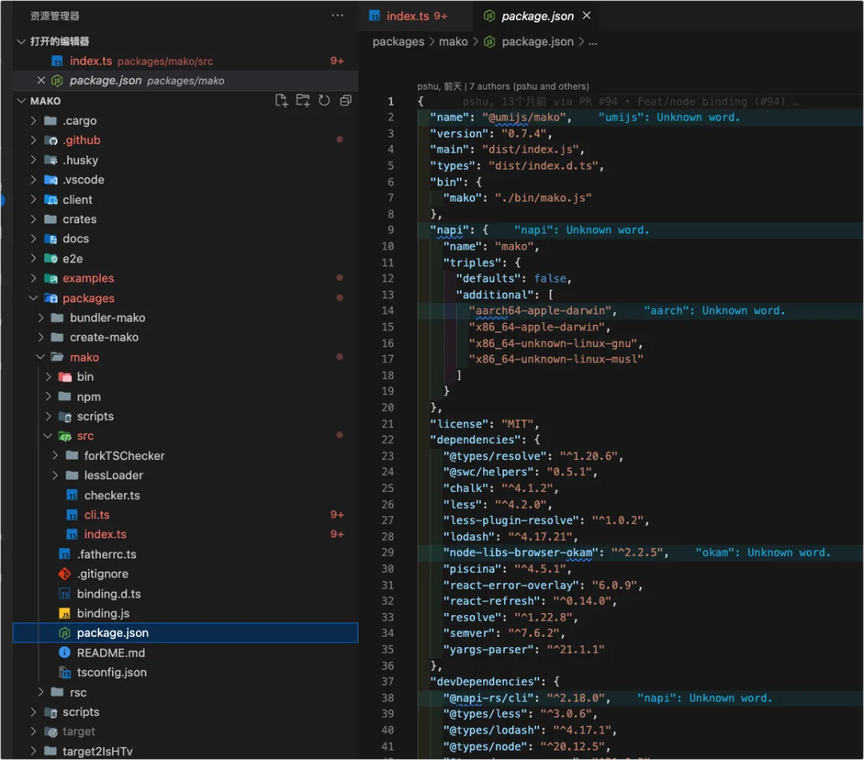
Compiler
在经过 cli 端、js 端、Rust 端的配置融合之后,会得到最终的配置。

基于这些配置,Mako 会生成一个 Compiler,来执行整个编译流程。

Compiler 中存在各种插件来执行任务,插件都拥有如下的生命周期,会在编译过程的各个阶段进行调用。
pub trait Plugin: Any + Send + Sync { fn name(&self) -> &str;
fn modify_config(&self, _config: &mut Config, _root: &Path, _args: &Args) -> Result<()> { Ok(()) }
fn load(&self, _param: &PluginLoadParam, _context: &Arc<Context>) -> Result<Option<Content>> { Ok(None) }
fn next_build(&self, _next_build_param: &NextBuildParam) -> bool { true }
fn parse( &self, _param: &PluginParseParam, _context: &Arc<Context>, ) -> Result<Option<ModuleAst>> { Ok(None) }
fn transform_js( &self, _param: &PluginTransformJsParam, _ast: &mut Module, _context: &Arc<Context>, ) -> Result<()> { Ok(()) }
fn after_generate_transform_js( &self, _param: &PluginTransformJsParam, _ast: &mut Module, _context: &Arc<Context>, ) -> Result<()> { Ok(()) }
fn before_resolve(&self, _deps: &mut Vec<Dependency>, _context: &Arc<Context>) -> Result<()> { Ok(()) }
fn after_build(&self, _context: &Arc<Context>, _compiler: &Compiler) -> Result<()> { Ok(()) }
fn generate(&self, _context: &Arc<Context>) -> Result<Option<()>> { Ok(None) }
fn after_generate_chunk_files( &self, _chunk_files: &[ChunkFile], _context: &Arc<Context>, ) -> Result<()> { Ok(()) }
fn build_success(&self, _stats: &StatsJsonMap, _context: &Arc<Context>) -> Result<Option<()>> { Ok(None) }
fn build_start(&self, _context: &Arc<Context>) -> Result<Option<()>> { Ok(None) }
fn generate_beg(&self, _context: &Arc<Context>) -> Result<()> { Ok(()) }
fn generate_end( &self, _params: &PluginGenerateEndParams, _context: &Arc<Context>, ) -> Result<Option<()>> { Ok(None) }
fn runtime_plugins(&self, _context: &Arc<Context>) -> Result<Vec<String>> { Ok(Vec::new()) }
fn optimize_module_graph( &self, _module_graph: &mut ModuleGraph, _context: &Arc<Context>, ) -> Result<()> { Ok(()) }
fn before_optimize_chunk(&self, _context: &Arc<Context>) -> Result<()> { Ok(()) }
fn optimize_chunk( &self, _chunk_graph: &mut ChunkGraph, _module_graph: &mut ModuleGraph, _context: &Arc<Context>, ) -> Result<()> { Ok(()) }
fn before_write_fs(&self, _path: &Path, _content: &[u8]) -> Result<()> { Ok(()) }}所有的插件又分为如下几类:
内置的分为两类的插件 11 种;
外部 js 编写的插件(Less 的编译就是使用这种);
其他条件型插件。
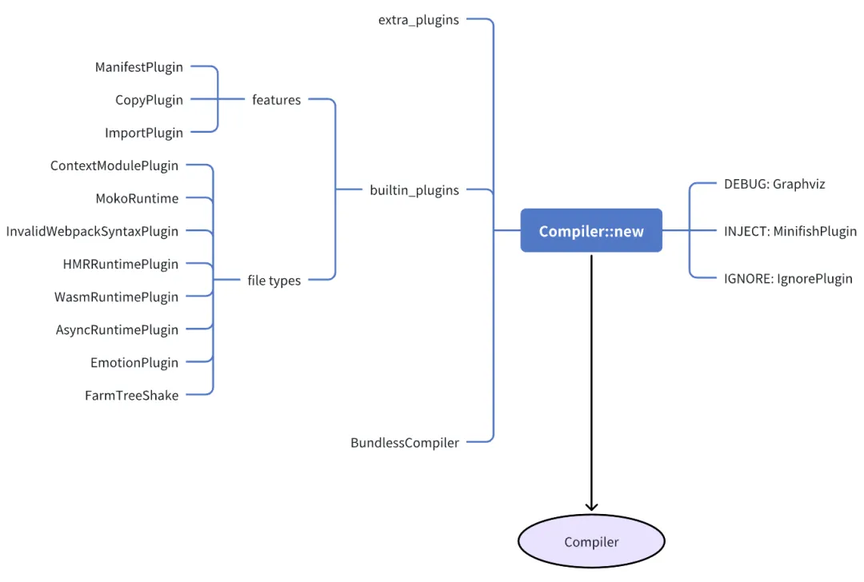
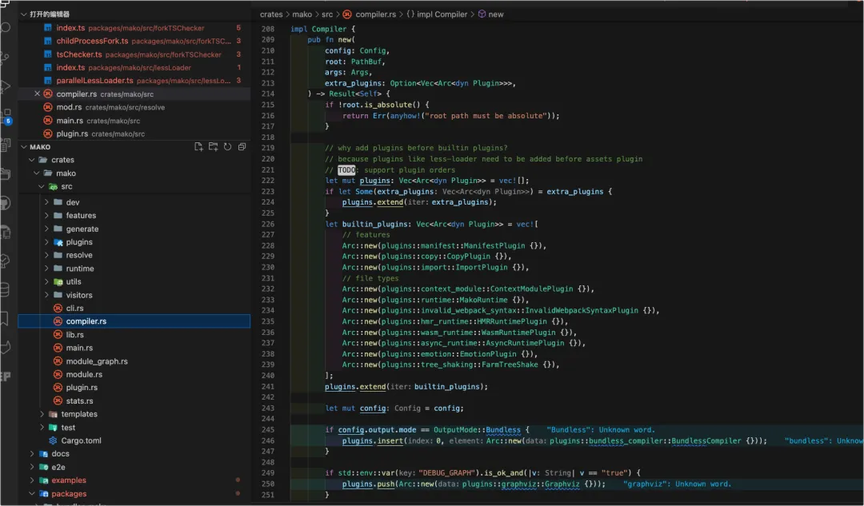
使用各种插件
在确定好本次编译要使用的插件后,会生成一个 PluginDriver,来进行整体生命周期的调度,并执行 modify_config 生命周期,确定最终的 config。

根据 plugins 创建 PluginDriver 调度所有插件的生命周期
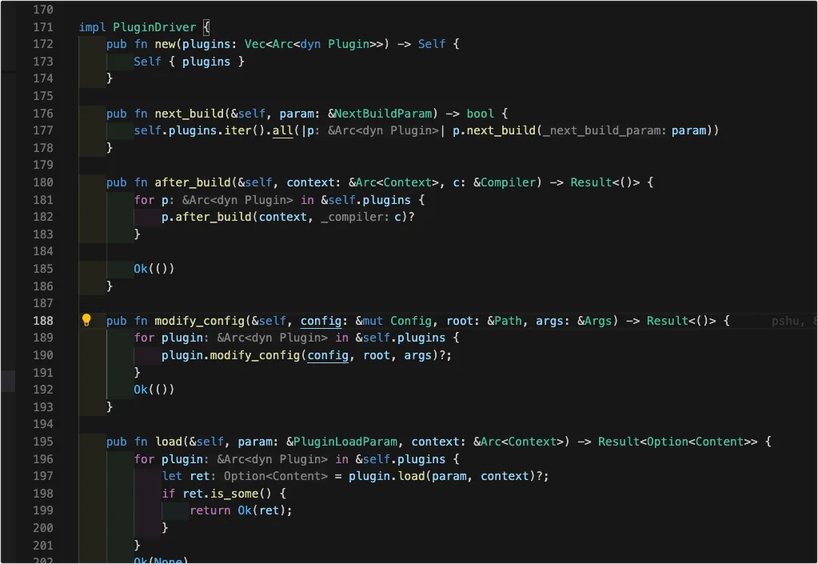
PluginDriver 的内部逻辑,即将执行所有插件对应的生命周期一一执行
下一步就是执行整个编译流程:
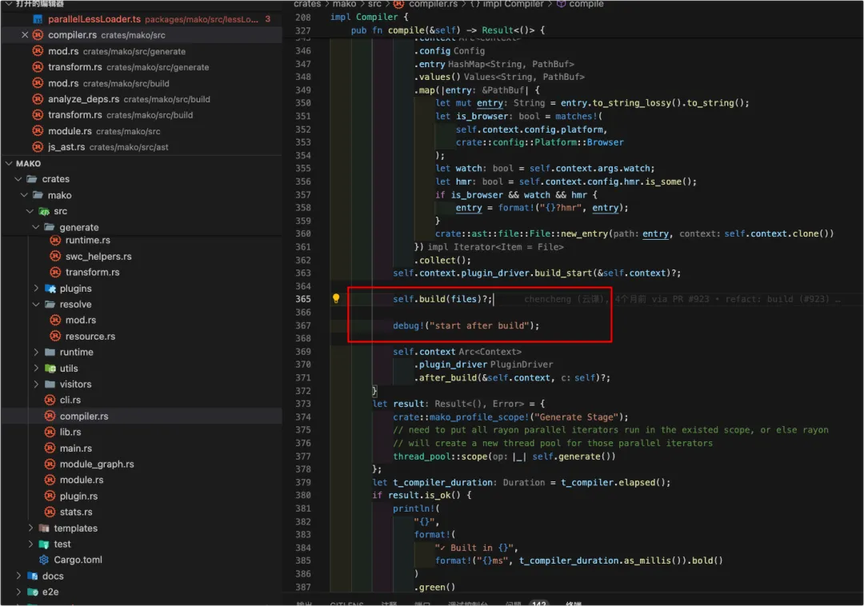
build
编译流程的实现,代码简化如下:
impl Compiler { pub fn build(&self, files: Vec<File>) -> Result<HashSet<ModuleId>> { let (rs, rr) = channel::<Result<Module>>();
let build_with_pool = |file: File, parent_resource: Option<ResolverResource>| { let rs = rs.clone(); let context = self.context.clone(); thread_pool::spawn(move || { let result = Self::build_module(&file, parent_resource, context.clone()); let result = Self::handle_build_result(result, &file, context); rs.send(result).unwrap(); }); }; let mut count = 0; for file in files { count += 1; build_with_pool(file, None); }
let mut errors = vec![]; let mut module_ids = HashSet::new();
for build_result in rr { count -= 1;
// handle build_module error if build_result.is_err() { errors.push(build_result.err().unwrap()); if count == 0 { break; } else { continue; } } let module = build_result.unwrap(); let module_id = module.id.clone(); // xxx } drop(rs);
if !errors.is_empty() { return Err(anyhow::anyhow!(BuildError::BuildTasksError { errors })); }
Ok(module_ids) }}Compiler 会创建管道,然后使用 rayon 的线程池进行构建任务的执行,执行完成后将结果通过管道送回,再执行后续操作。
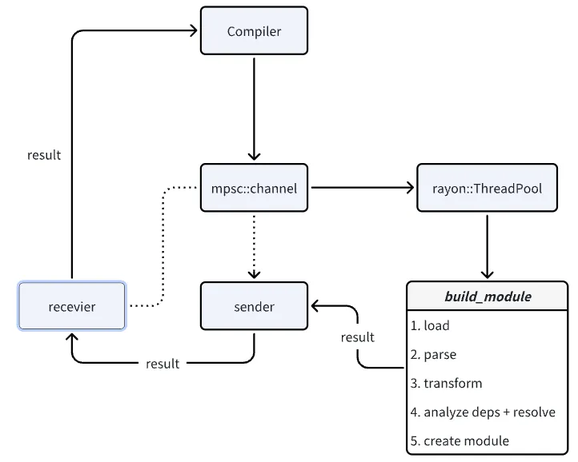
build_module 实现如下:
pub fn build_module( file: &File, parent_resource: Option<ResolverResource>, context: Arc<Context>,) -> Result<Module> { // 1. load let mut file = file.clone(); let content = load::Load::load(&file, context.clone())?; file.set_content(content);
// 2. parse let mut ast = parse::Parse::parse(&file, context.clone())?;
// 3. transform transform::Transform::transform(&mut ast, &file, context.clone())?;
// 4. analyze deps + resolve let deps = analyze_deps::AnalyzeDeps::analyze_deps(&ast, &file, context.clone())?;
// 5. create module let path = file.path.to_string_lossy().to_string(); let module_id = ModuleId::new(path.clone()); let raw = file.get_content_raw(); let is_entry = file.is_entry; let source_map_chain = file.get_source_map_chain(context.clone()); let top_level_await = match &ast { ModuleAst::Script(ast) => ast.contains_top_level_await, _ => false, }; let is_async_module = file.extname == "wasm"; let is_async = is_async_module || top_level_await;
// raw_hash is only used in watch mode // so we don't need to calculate when watch is off let raw_hash = if context.args.watch { file.get_raw_hash() .wrapping_add(hash_hashmap(&deps.missing_deps)) } else { 0 }; let info = ModuleInfo { file, deps, ast, resolved_resource: parent_resource, source_map_chain, top_level_await, is_async, raw_hash, raw, ..Default::default() }; let module = Module::new(module_id, is_entry, Some(info)); Ok(module)}build_module 执行阶段解析:
Load
根据路径加载文件,目前内置如下类型(支持通过插件的 Load 生命周期配置自定义文件)
virtual:inline_css:runtime
?raw
js
css
md & mdx
svg
toml
wasm
xml
yaml
json
assets
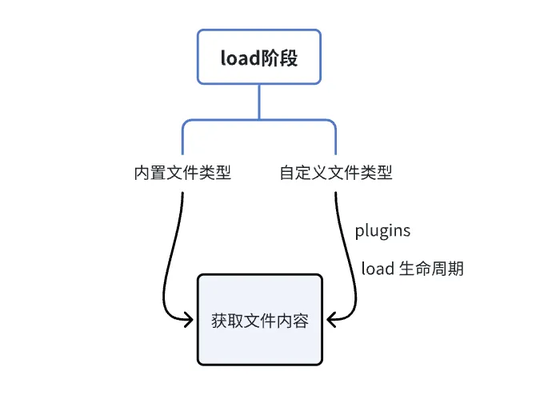
impl Load { pub fn load(file: &File, context: Arc<Context>) -> Result<Content> { crate::mako_profile_function!(file.path.to_string_lossy()); debug!("load: {:?}", file);
// plugin first let content: Option<Content> = context .plugin_driver .load(&PluginLoadParam { file }, &context)?;
if let Some(content) = content { return Ok(content); }
// virtual:inline_css:runtime if file.path.to_str().unwrap() == "virtual:inline_css:runtime" { return Ok(Content::Js(JsContent { content: r#"export function moduleToDom(css) { var styleElement = document.createElement("style"); styleElement.type = "text/css"; styleElement.appendChild(document.createTextNode(css)) document.head.appendChild(styleElement);} "# .to_string(), ..Default::default() })); }
// file exists check must after virtual modules handling if !file.pathname.exists() || !file.pathname.is_file() { return Err(anyhow!(LoadError::FileNotFound { path: file.path.to_string_lossy().to_string(), })); }
// unsupported if UNSUPPORTED_EXTENSIONS.contains(&file.extname.as_str()) { return Err(anyhow!(LoadError::UnsupportedExtName { ext_name: file.extname.clone(), path: file.path.to_string_lossy().to_string(), })); }
// ?raw if file.has_param("raw") { let content = FileSystem::read_file(&file.pathname)?; let content = serde_json::to_string(&content)?; return Ok(Content::Js(JsContent { content: format!("module.exports = {}", content), ..Default::default() })); }
// js if JS_EXTENSIONS.contains(&file.extname.as_str()) { // entry with ?hmr let is_jsx = file.extname.as_str() == "jsx" || file.extname.as_str() == "tsx"; if file.is_entry && file.has_param("hmr") { let content = format!( "{}\nmodule.exports = require(\"{}\");\n", include_str!("../runtime/runtime_hmr_entry.js"), file.pathname.to_string_lossy(), ); return Ok(Content::Js(JsContent { content, is_jsx })); } let content = FileSystem::read_file(&file.pathname)?; return Ok(Content::Js(JsContent { content, is_jsx })); }
// css if CSS_EXTENSIONS.contains(&file.extname.as_str()) { let content = FileSystem::read_file(&file.pathname)?; return Ok(Content::Css(content)); }
// md & mdx if MD_EXTENSIONS.contains(&file.extname.as_str()) { let content = FileSystem::read_file(&file.pathname)?; let options = MdxOptions { development: matches!(context.config.mode, Mode::Development), ..Default::default() }; let content = match compile(&content, &options) { Ok(js_string) => js_string, Err(reason) => { return Err(anyhow!(LoadError::CompileMdError { path: file.path.to_string_lossy().to_string(), reason, })); } }; let is_jsx = file.extname.as_str() == "mdx"; return Ok(Content::Js(JsContent { content, is_jsx })); }
// svg // TODO: Not all svg files need to be converted to React Component, unnecessary performance consumption here if SVG_EXTENSIONS.contains(&file.extname.as_str()) { let content = FileSystem::read_file(&file.pathname)?; let svgr_transformed = svgr_rs::transform( content, svgr_rs::Config { named_export: SVGR_NAMED_EXPORT.to_string(), export_type: Some(svgr_rs::ExportType::Named), ..Default::default() }, svgr_rs::State { ..Default::default() }, ) .map_err(|err| LoadError::ToSvgrError { path: file.path.to_string_lossy().to_string(), reason: err.to_string(), })?; let asset_path = Self::handle_asset(file, true, true, context.clone())?; return Ok(Content::Js(JsContent { content: format!("{}\nexport default {};", svgr_transformed, asset_path), is_jsx: true, })); }
// toml if TOML_EXTENSIONS.contains(&file.extname.as_str()) { let content = FileSystem::read_file(&file.pathname)?; let content = from_toml_str::<TomlValue>(&content)?; let content = serde_json::to_string(&content)?; return Ok(Content::Js(JsContent { content: format!("module.exports = {}", content), ..Default::default() })); }
// wasm if WASM_EXTENSIONS.contains(&file.extname.as_str()) { let final_file_name = format!( "{}.{}.{}", file.get_file_stem(), file.get_content_hash()?, file.extname ); context.emit_assets( file.pathname.to_string_lossy().to_string(), final_file_name.clone(), ); return Ok(Content::Js(JsContent { content: format!( "module.exports = require._interopreRequireWasm(exports, \"{}\")", final_file_name ), ..Default::default() })); }
// xml if XML_EXTENSIONS.contains(&file.extname.as_str()) { let content = FileSystem::read_file(&file.pathname)?; let content = from_xml_str::<serde_json::Value>(&content)?; let content = serde_json::to_string(&content)?; return Ok(Content::Js(JsContent { content: format!("module.exports = {}", content), ..Default::default() })); }
// yaml if YAML_EXTENSIONS.contains(&file.extname.as_str()) { let content = FileSystem::read_file(&file.pathname)?; let content = from_yaml_str::<YamlValue>(&content)?; let content = serde_json::to_string(&content)?; return Ok(Content::Js(JsContent { content: format!("module.exports = {}", content), ..Default::default() })); }
// json if JSON_EXTENSIONS.contains(&file.extname.as_str()) { let content = FileSystem::read_file(&file.pathname)?; return Ok(Content::Js(JsContent { content: format!("module.exports = {}", content), ..Default::default() })); }
// assets let asset_path = Self::handle_asset(file, true, true, context.clone())?; Ok(Content::Js(JsContent { content: format!("module.exports = {};", asset_path), ..Default::default() })) }}Parse
将源文件解析为 ModuleAst 类型,现阶段内置了 Script 和 Css 两种 swc ast 的封装,在这个阶段会执行 plugins 中的 parse 生命周期,可以在这个生命周期中进行自定义语法的 ast 解析。
比如想支持鸿蒙的 ets,编写插件的话就需要在这个阶段进行 ast 解析
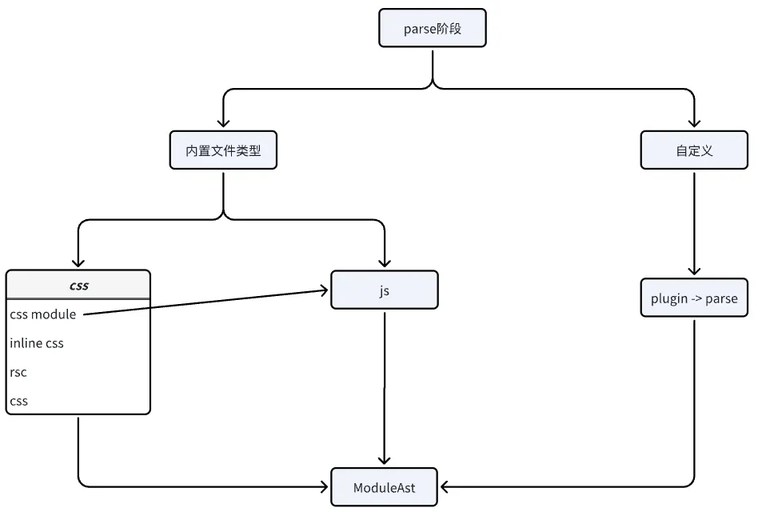
impl Parse { pub fn parse(file: &File, context: Arc<Context>) -> Result<ModuleAst> { // plugin first let ast = context .plugin_driver .parse(&PluginParseParam { file }, &context)?; if let Some(ast) = ast { return Ok(ast); }
// js if let Some(Content::Js(_)) = &file.content { debug!("parse js: {:?}", file.path); let ast = JsAst::new(file, context.clone())?; if let Some(ast) = Rsc::parse_js(file, &ast, context.clone())? { return Ok(ast); } return Ok(ModuleAst::Script(ast)); }
// css if let Some(Content::Css(_)) = &file.content { // xxx }
}}transform
使用 swc,通过各种 visitor 进行 ast 的转换操作,生成最终的 ast。
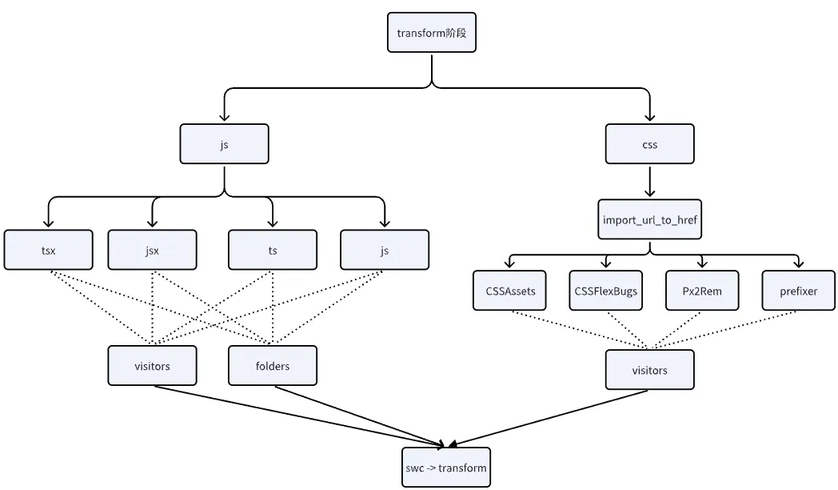
impl Transform { pub fn transform(ast: &mut ModuleAst, file: &File, context: Arc<Context>) -> Result<()> { crate::mako_profile_function!(); match ast { ModuleAst::Script(ast) => { GLOBALS.set(&context.meta.script.globals, || { let unresolved_mark = ast.unresolved_mark; let top_level_mark = ast.top_level_mark; let cm: Arc<swc_core::common::SourceMap> = context.meta.script.cm.clone(); let origin_comments = context.meta.script.origin_comments.read().unwrap(); let is_ts = file.extname == "ts"; let is_tsx = file.extname == "tsx"; let is_jsx = file.is_content_jsx() || file.extname == "jsx" || file.extname == "js" || file.extname == "ts" || file.extname == "tsx";
// visitors let mut visitors: Vec<Box<dyn VisitMut>> = vec![ Box::new(resolver(unresolved_mark, top_level_mark, is_ts || is_tsx)), Box::new(FixHelperInjectPosition::new()), Box::new(FixSymbolConflict::new(top_level_mark)), Box::new(NewUrlAssets { context: context.clone(), path: file.path.clone(), unresolved_mark, }), Box::new(WorkerModule::new(unresolved_mark)), ]; if is_tsx { visitors.push(Box::new(tsx_strip( cm.clone(), context.clone(), top_level_mark, ))) } if is_ts { visitors.push(Box::new(ts_strip(top_level_mark))) } // named default export if context.args.watch && !file.is_under_node_modules && is_jsx { visitors.push(Box::new(DefaultExportNamer::new())); } // react & react-refresh let is_dev = matches!(context.config.mode, Mode::Development); let is_browser = matches!(context.config.platform, crate::config::Platform::Browser); let use_refresh = is_dev && context.args.watch && context.config.hmr.is_some() && !file.is_under_node_modules && is_browser; if is_jsx { visitors.push(react( cm, context.clone(), use_refresh, &top_level_mark, &unresolved_mark, )); }
{ let mut define = context.config.define.clone(); let mode = context.config.mode.to_string(); define .entry("NODE_ENV".to_string()) .or_insert_with(|| format!("\"{}\"", mode).into()); let env_map = build_env_map(define, &context)?; visitors.push(Box::new(EnvReplacer::new( Lrc::new(env_map), unresolved_mark, ))); } visitors.push(Box::new(TryResolve { path: file.path.to_string_lossy().to_string(), context: context.clone(), unresolved_mark, })); visitors.push(Box::new(Provide::new( context.config.providers.clone(), unresolved_mark, top_level_mark, ))); visitors.push(Box::new(VirtualCSSModules { auto_css_modules: context.config.auto_css_modules, })); visitors.push(Box::new(ContextModuleVisitor { unresolved_mark })); if context.config.dynamic_import_to_require { visitors.push(Box::new(DynamicImportToRequire { unresolved_mark })); } if matches!(context.config.platform, crate::config::Platform::Node) { visitors.push(Box::new(features::node::MockFilenameAndDirname { unresolved_mark, current_path: file.path.clone(), context: context.clone(), })); }
// folders let mut folders: Vec<Box<dyn Fold>> = vec![]; folders.push(Box::new(decorators(decorators::Config { legacy: true, emit_metadata: false, ..Default::default() }))); let comments = origin_comments.get_swc_comments().clone(); let assumptions = context.assumptions_for(file);
folders.push(Box::new(swc_preset_env::preset_env( unresolved_mark, Some(comments), swc_preset_env::Config { mode: Some(swc_preset_env::Mode::Entry), targets: Some(swc_preset_env_targets_from_map( context.config.targets.clone(), )), ..Default::default() }, assumptions, &mut FeatureFlag::default(), ))); folders.push(Box::new(reserved_words::reserved_words())); folders.push(Box::new(paren_remover(Default::default()))); folders.push(Box::new(simplifier( unresolved_mark, SimpilifyConfig { dce: dce::Config { top_level: false, ..Default::default() }, ..Default::default() }, )));
ast.transform(&mut visitors, &mut folders, file, true, context.clone())?;
Ok(()) }) } ModuleAst::Css(ast) => { // replace @import url() to @import before CSSUrlReplacer import_url_to_href(&mut ast.ast); let mut visitors: Vec<Box<dyn swc_css_visit::VisitMut>> = vec![]; visitors.push(Box::new(Compiler::new(compiler::Config { process: swc_css_compat::feature::Features::NESTING, }))); let path = file.path.to_string_lossy().to_string(); visitors.push(Box::new(CSSAssets { path, context: context.clone(), })); // same ability as postcss-flexbugs-fixes if context.config.flex_bugs { visitors.push(Box::new(CSSFlexbugs {})); } if context.config.px2rem.is_some() { let context = context.clone(); visitors.push(Box::new(Px2Rem::new( context.config.px2rem.as_ref().unwrap().clone(), ))); } // prefixer visitors.push(Box::new(prefixer::prefixer(prefixer::options::Options { env: Some(targets::swc_preset_env_targets_from_map( context.config.targets.clone(), )), }))); ast.transform(&mut visitors)?;
// css modules let is_modules = file.has_param("modules"); if is_modules { CssAst::compile_css_modules(file.pathname.to_str().unwrap(), &mut ast.ast); }
Ok(()) } ModuleAst::None => Ok(()), } }}analyze deps+resolve
ast 解析完成后,进行依赖的分析。
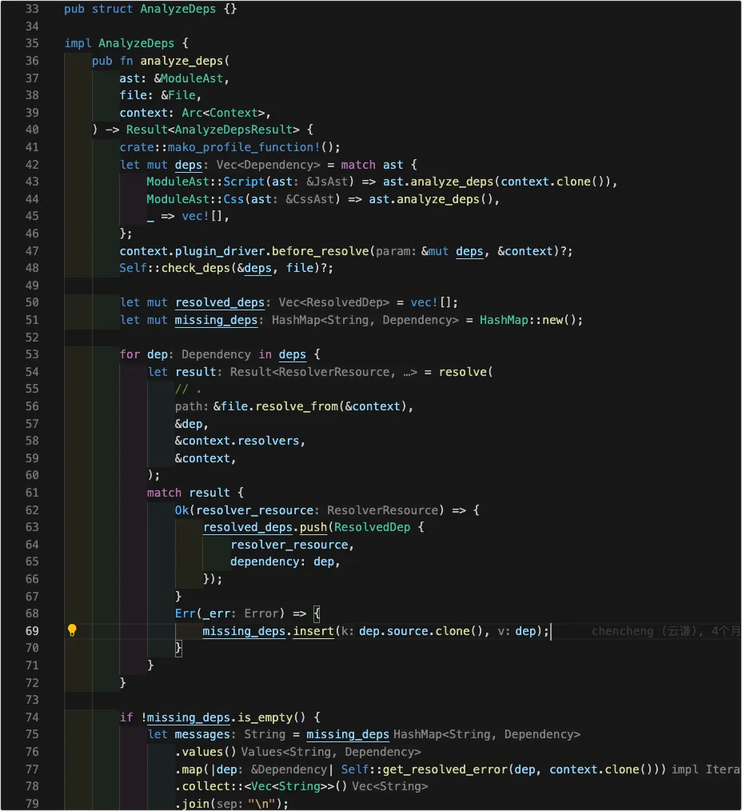
依赖分析阶段
有个很有意思的事情是我看到代码中有使用 oxc_resolver,一开始有点好奇,以为是什么黑科技,因为 oxc 和 swc 是同类型的工具,一般不会出现在同一个项目中。经过查找之后发现,是之前的 resolver 有点问题,作为替换才使用的 oxc 的 resolver 模块。也就是解析还是使用的 swc,oxc 只用到了 resolver。具体可参考 https://github.com/umijs/mako/pull/919。
create module
ast 处理完成、依赖分析完成后,将所有元数据进行合并,为一个 Module,执行后续操作。
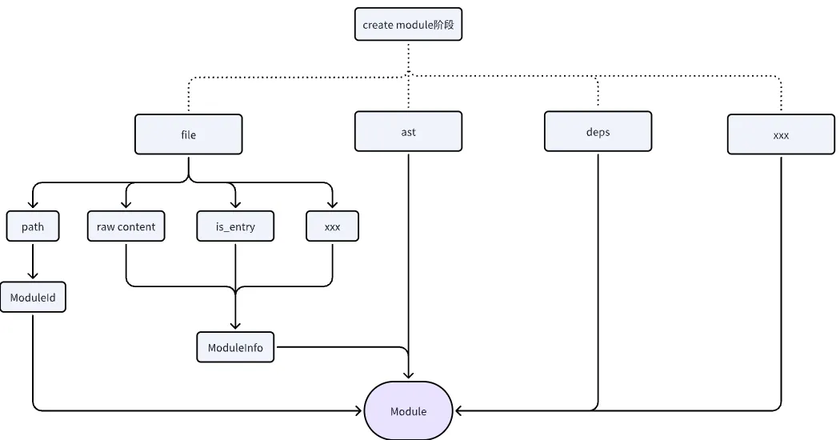
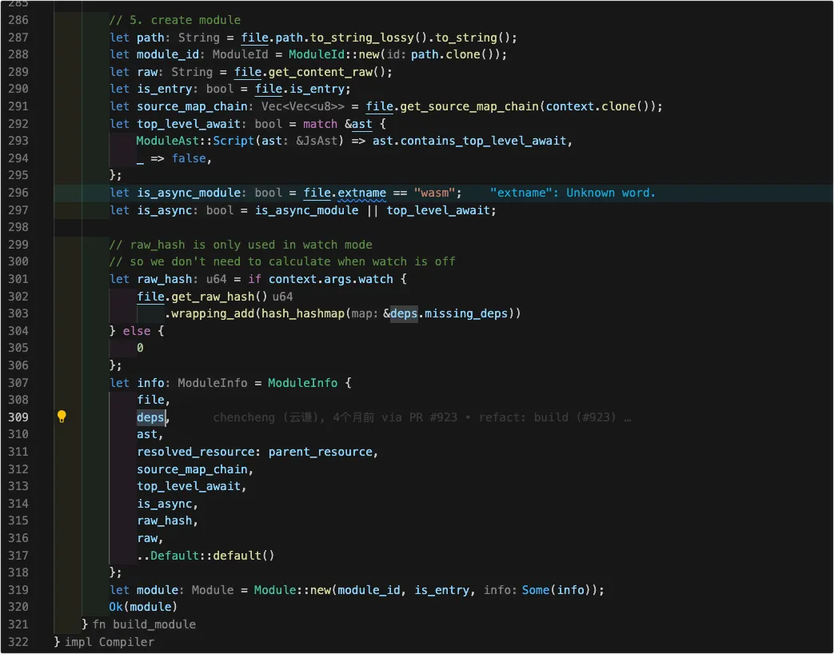
create Module 阶段
至此,核心编译流程已经完成。
生成
编译完成后,来到了整个构建流程的最后一步:生成,整体架构如下:
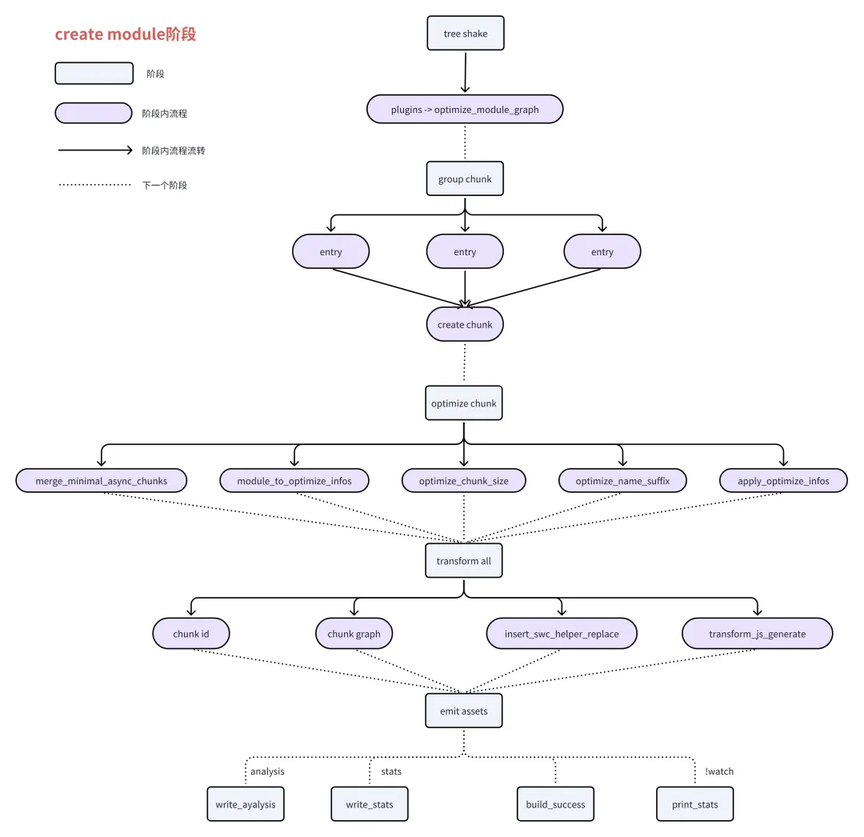

生成阶段
五、尾声
最开始以为 Mako 会像 Rspack 一样,走的是 Webpack 的路子,看完后觉得 Mako 的设计思路是 rollup 一样的,通过各种的 plugin 来完成一个构建工具的功能。
正如其官网所说:
Mako 不是为了与 Webpack 的社区加载器和插件兼容而设计的。如果你的项目严重依赖于 Webpack 的社区加载器和插件,你不应该使用 Mako,Rspack 是更好的选择。
一家之言,还请各位指正。
*文/ asarua
本文属得物技术原创,更多精彩文章请看:得物技术
未经得物技术许可严禁转载,否则依法追究法律责任!
版权声明: 本文为 InfoQ 作者【得物技术】的原创文章。
原文链接:【http://xie.infoq.cn/article/f5fea0a08b9043117dae8e18e】。文章转载请联系作者。
得物技术
得物APP技术部 2019-11-13 加入
关注微信公众号「得物技术」








评论